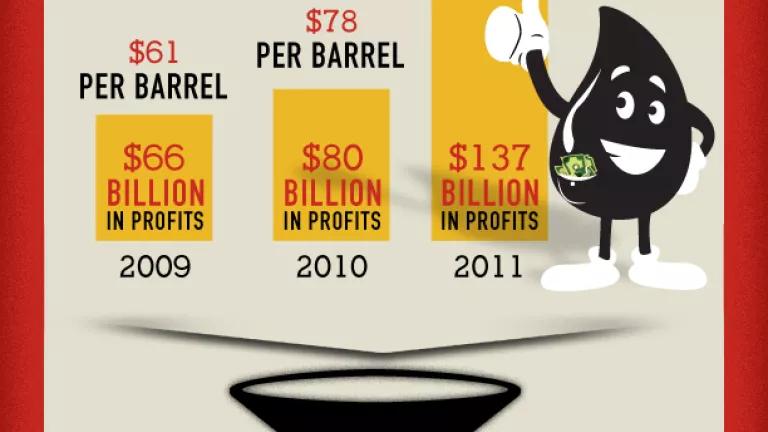
Over thirty million Americans will be on the road this Memorial Day holiday weekend heading to vacation with family and friends according to a survey produced by the automobile group AAA. With so many travelers inevitably having to stop at the gasoline station, below is a reminder of what will –and what won’t – make a difference to our gasoline bills.
As the graphic shows, most of the money that consumers spend on gasoline goes to oil companies that produce crude oil – the main ingredient of gasoline – and not to your typical mom-and-pop gas station owner. As oil prices have gone up, so have the profits of the oil industry. The top five publicly-traded oil companies earned a whopping $137 billion last year in profits. [i] Yet expanded U.S. domestic drilling, as it turns out, has done nothing to lower gasoline bills. The biggest impact that is being made to lower gasoline bills is the increased choice of fuel efficient cars and trucks being offered, thanks to national fuel efficiency standards.
Four Facts to Remember While at the Pump:
1. Most of your gasoline payment actually goes to the oil companies that produce crude oil, not the retail station.
As the graphic below illustrates, oil companies that produce crude oil – the main ingredient of gasoline – collect the majority of your gasoline dollars as well as make the most profit, as I showed in an earlier blog. The companies include publically traded ones like ExxonMobil, BP, Chevron, ConocoPhillips and Shell. But they also include the one’s you’ve never heard of - nationally owned oil companies such as Saudi Arabia’s Aramaco, Venezuela’s PDVSA, and many others -- that control 90% of the oil reserves and 73% of actual oil production.
2. The oil industry’s profits increase as world oil prices increase
As the past three years have shown, increased world oil prices – and with it increased gasoline prices -- have translated to record profits for the industry. The five largest publically-traded oil companies listed above recorded profits of $137 billion in 2011.[ii] What are the drivers of these increases in oil and gasoline prices? Most experts point to the world's growing appetite for oil, particularly from China and India, together with tensions in the Middle East, causing oil prices to go up.
3. More U.S. domestic drilling hasn’t lowered our gasoline bills
The Associated Press hired four independent statisticians to analyze 36 years of data on gasoline prices and U.S. domestic oil production. They found:
"No statistical correlation between how much oil comes out of U.S. wells and the price at the pump."
In fact, gasoline prices have actually increased the past three years despite domestic oil production levels reaching an all time high since 1998. The main reason is that oil is a global commodity with the U.S. exerting little control over those global prices which are largely influenced by OPEC. The U.S. produces 7% of the world’s crude oil and controls less than 2% of the world’s oil reserves.
4. More choices of fuel efficient vehicles and clean alternatives to gasoline are the best ways to relieve pain-at-the-pump.
Thanks largely to new national fuel efficiency standards, consumers now have an array of fuel efficient choices whether they’re looking for a passenger car, crossovers, SUVs, or pickup trucks. Fuel efficiency now ranks as the leading consideration for consumers when shopping for cars. And it doesn’t take a market expert to understand why. For a 18 mile-per-gallon gas hog, the fuel costs are 21 cents a mile (at $3.85 per gallon gasoline). Compare that a 50 mile-per-gallon gas miser with fuel costs of only 8 cents a mile.
Clean fuel standards are also resulting in more alternatives to gasoline. These alternative fuels – such as electricity and sustainable renewable fuels - substitute for gasoline and help provide consumers with potentially more stable and lower cost fuels. For example, powering a plug-in electric vehicle from your home outlet is like the equivalent of paying just one dollar a gallon gasoline.
This weekend, the best medicine to any pain-at-the-pump blues is to know what works – and what doesn’t – to reduce our gasoline bills.
[i] Based on company annual reports for 2009, 2010, and 2011 for BP, Chevron, ConcoPhillips, ExxonMobil, and Shell.
[ii] Ibid.

